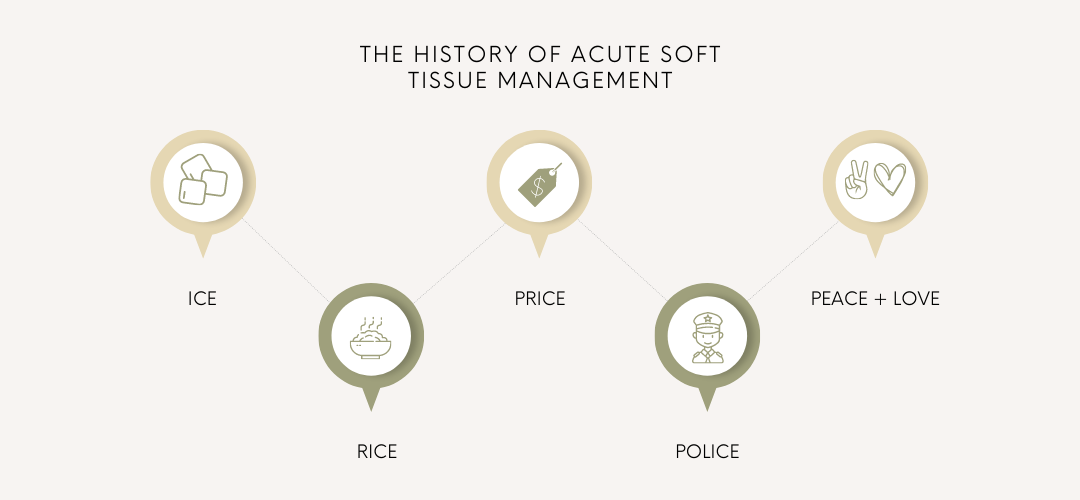Stop doing RICE for soft tissue injuries!
Did you know that we haven't been doing RICE for soft tissues for over a decade?
Let's start from the very beginning - a very good place to start!
Originally the basic principle for dealing with acute soft tissue injuries (rolled ankle, hamstring tear, etc.) was ICE - Ice, Compression and Elevation. The evidence for these mainly focused around the analgesic effect on ice, and the associated skin/intramuscular temperature changes [2].
Rest was then added into the acronym and the famous RICE or RICER (the second R being referral, for non-health professionals) was born! Which came from the rationale that the soft tissue injury should undergo a period of unloading, where the injured site isn’t placed under any stress to “allow it to heal”.
Shortly after (Early 2000's), Protect came into the picture and thus PRICE became the new go to for injuries. I'm not sure about you, but I don't remember getting this memo about this one. Either way, the rationale was similar to rest - we need to protect/immobilise/rest the joint/muscle so that it can heal.
Getting rid of the R
In 2012, Bleakley, Glasgow and MacAuley, wrote a paper called "PRICE needs updating, should we call the POLICE?" - which talked about the need to get rid of "Rest" from the acronym.
Their rationale was that “Rest” which supposed to have only been done for a very short period, was being over done, and as such was actually harmful and inhibits recovery.
As such, “Loading” replaced “Rest”, and “OL“ (for “Optimal Loading”) was introduced to the acronym (PLICE just doesn't roll off the tongue), replacing rest with a "balanced and incremental rehabilitation programme where early activity encourages early recovery".
A new challenger approaches: The anti-inflammatory
In the meanwhile, throughout all these changes to our sacred acronym, lurking in the shadows, the non-steroidal anti-inflammatory drugs (NSAIDs) started becoming an increasing popular method to help manage pain and swelling in soft tissue injuries.
It made sense, as NSAIDs on paper seem to be on the same team as RICE/PRICE/POLICE. Reducing swelling, reducing pain, those sound like some pretty good things.
The anti-anti-inflammatory revolution
As time went on, there was significant evidence against the use of NSAIDs - with the research indicating that it was actually doing more harm in the long term.
Essentially, NSAIDs inhibit an enzyme known as COX-2, which helps stop the inflammatory part of the acute phase, but in turn results in impaired skeletal muscle growth, delayed skeletal muscle repair and increased fibrosis. [3]
Duschesne, Dufresne and Dumont (2017) actually came up with a decision-making tree for using NSAIDs in the management of muscle disorders in a clinical setting - see below. Incase you can't tell, the bottom line is essentially - "you shouldn't really need to".
So with that, the NSAIDs breathed their last breath, but at what cost?
Ice gets... frozen out (sorry, not sorry for the pun)
With the fall-out of NSAIDs, the effectiveness of all anti-inflammatory modalities came into question.
To save you the debates, ultimately it was found that ice is mostly analgesic (pain relief) in nature, has pretty poor high quality evidence about whether it really helps in acute soft tissue injuries [4], and may potentially disrupt, delay, and inhibit some parts of the healing process.
The most ridiculous, unnecessarily long, but evidence-based acronym
If you've made it this far (and haven't skipped), I commend you for your perseverance.
With the removal of ice, the need to deter people away from NSAIDs and other anti-inflammatory modalities, and the ever increasing push to encourage movement and rehabilitation, a new acronym formed to encapsulate everything - PEACE & LOVE. Yep. Good luck remembering what all these stand for.
It's split intentionally into the 2 words, and so I'll end this blog with the punny explanation from Dubois and Esculier [1], recommending "Immediately after injury, do no HARM (Heat, Alcohol, Running, Massage), and let PEACE guide your approach." Then "after a few days have passed, soft tissues need LOVE".
This blog and the contents within are shared to enrich the understanding that members of the Elevation One community have in relation to physiotherapy and general health. It should not be used to diagnose any medical conditions and is not health advice. We always recommend seeking a medical professional for your health concerns.
[1] Dubois B, Esculier J. Soft-tissue injuries simply need PEACE and LOVE, British Journal of Sports Medicine 2020;54:72-73.
[2] Bleakley CM, Glasgow P, MacAuley DC. PRICE needs updating, should we call the POLICE? British Journal of Sports Medicine 2012;46:220-221.
[3] Elise Duchesne, Sébastien S. Dufresne, Nicolas A. Dumont, Impact of Inflammation and Anti-inflammatory Modalities on Skeletal Muscle Healing: From Fundamental Research to the Clinic, Physical Therapy 2017; 97:807-817.
[4] Petersen, W., Rembitzki, I. V., Koppenburg, A. G., Ellermann, A., Liebau, C., Brüggemann, G. P., & Best, R. Treatment of acute ankle ligament injuries: a systematic review. Archives of orthopaedic and trauma surgery 2013;133:1129-1141.



